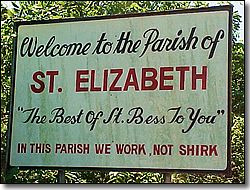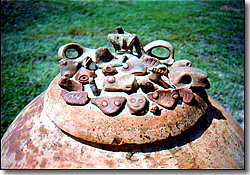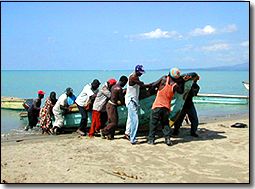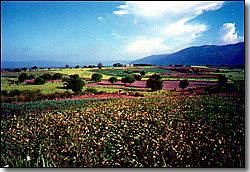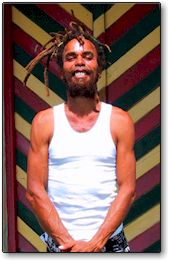Treasure Beach is located within the parish of St. Elizabeth, known island-wide for having the friendliest and hardest working people found anywhere in Jamaica. The sign welcoming visitors to the parish states, "In this parish we work, not shirk". This well-deserved reputation derives from a work ethic instilled in generations of farmers and fishermen and is one more way in which Treasure Beach is set apart from the rest of the island.
|
The Hardest Working Parish in JA |
| Even the landscape of Treasure Beach is distinct. We are known as the desert coast of Jamaica because we have the least amount of rainfall on the island. This lack of precipitation is due to the natural barrier provided by the Santa Cruz Mountains to the east. Many visitors have made the comment that this area reminds them of the savannahs of East Africa. The closer you come to Treasure Beach the more you see flat plains with fields of low scrub grass, a variety of cacti (some reaching several feet tall), acacia trees, and lignum vitae trees. Worth noting is the lignum vitae, found in few locations around the world (and only on the south coast in Jamaica) because they survive in a dry, arid climate. Its small purple blossom is Jamaica's national flower and many people use the leaf for rubbing on cuts and insect bites. | (For an "insider's view" on the area, check out Don Noel's book, Near a Far Sea, in the Eat and Play section) The desert south coast |
| The first residents of Treasure Beach were the Tainos Indians, coming to Jamaica around 700 AD. The Tainos were small in stature averaging five feet in height, with light brown skin and broad faces. One interesting fact about the Tainos was that they felt a pointed skull was something to be proud of and, therefore, used to bind up a baby’s head using two wooden boards on either side ensuring the desired results. Tainos were peaceful and non-materialistic believing in community living where women gather the food and men fish and hunt. They were skilled potters, carvers, weavers, boat builders, fishermen, and farmers. As a result of the large population of Tainos which settled in the Treasure Beach area around 1494 AD it is possible to go for a walk through a meadow and find bits and pieces of Taino pottery lying on the ground (especially after a hard rainfall). Unfortunately, when the Spanish "discovered" Jamaica they captured and enslaved the Tainos who perished due to their deplorable treatment. It is said that some were able to escape in boats and made it to parts of the Americas (including south Florida) where small Taino communities are still found today. Some Taino words you may be familiar with are canoe, hammock, hurricane and tobacco. |
Taino artifacts found in Treasure Beach by Ted Tatham |
| Fishing is the major industry in Treasure Beach. Talk to any longtime resident and they will tell stories of several generations of fishermen dating back 200 years. The fishermen today still use both a seine net and traps (or pots) for catching their fish, but their vessels have changed from a wooden "dugout canoe" --carved from a large cottonwood tree-- to a cottonwood and fiberglass boat propelled by a 40 HP engine. Many make their living on the Cays,a few small sand spit islands surrounded by fertile fishing banks located 60 miles off Jamaica's South Coast, only coming home to visit a few times a year. When a boat comes in after a day at sea, the beach fills up with local residents checking out the catch of the day. We encourage you to take part in this event and watch the colorful fish, lobster, crab, etc. being unloaded, weighed, sorted, iced and sent out in trucks for sale across the island. Talk directly to the fishermen if you want to take some home for dinner. |
Fishing done much as it was 200 years ago. Courtesy of Lee Weitzman |
| Farming is the area's second biggest industry. In spite of its low rainfall, St. Elizabeth is nicknamed "The Bread Basket of Jamaica" because they supply more fruits and vegetables to the rest of the island than any other parish. The drier climate has led to the use of "mulch farming" --laying a thick layer of guinea grass over the planted field keeping in the moisture-- and planting low-water crops such as watermelon, scallion, and onion. Local irrigation typically consists of several 55 gallon drums filled with water and a bucket for watering individual plants. When driving through the area, take advantage of the many farm stands set up along the side of the road and purchase some of their fresh fruits and vegetables. In Treasure Beach watch for the famous "donkey ladies" and vegetable trucks selling fresh produce daily. |
Farm land of St. Elizabeth |
| The history of Treasure Beach would not be complete without telling the tale of a Scottish ship sinking off the coast in the mid-1600 s. The survivors swam to shore and settled in the area. The inevitable intermixing with the local population has led to the prevalence of residents with light skin, blue and green eyes, and blond and red hair. Across the island they are instantly recognized as "brownin's" or "red men" from Treasure Beach. All we know is it makes for some truly beautiful people! |
A Red Man of Treasure Beach |
|
top | treasurebeach.net | site map © 1999 - 2006 This site was created by WebTonic. |
